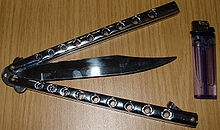Balisong
| Balisong | |
|---|---|

|
|
| Information | |
| Weapon type: | knife |
| Use: | Weapon and tool |
| Creation time: | approx. 16th century |
| Working time: | til today |
| Region of origin / author: |
Philippines , people of the Filipinos |
| Distribution: | Philippines, today worldwide |
| Blade length: | approx. 4 to 50 cm |
| Handle: | Wood, horn, ivory, metal |
| Lists on the subject | |
A balisong (popularly also "butterfly knife", in short: "butterfly") is a folding knife with two-part swiveling handles. The term balisong comes from the Tagalog and is a combination of the two words balí ("break") and sungay ("horn"). In the Philippines , another name for the knife is bente-nuebe ( Spanish veintinueve , twenty-nine ), corresponding to its average length in centimeters.
construction
The balisong has two halves of the handle that can be pivoted by 180 ° and are connected to the blade by an axle pin. A locking pin at the other end holds the two halves of the handle together in both the unfolded and folded-in state. The handles often contain holes to make the knife lighter and at the same time safer to grip, and the locking pin is also used for orientation between the safe handle and the bite handle.
history
The history of the balisong knife is not exactly known. There are two different versions in circulation, but neither of them can be clearly proven.
One theory is that the balisong was developed as a fishing knife in the Philippines. The fishermen there needed a working knife , the resting blade of which was harmless if it fell on the swaying boat. The blade of the balisong is completely enclosed in the two handle parts when at rest and therefore cannot injure anyone. The simple and dirt-resistant opening mechanism also allows the knife to be quickly ready for use when working with a flick of the wrist, which offsets the disadvantage of the unstable construction for a work knife . This thesis is further supported by the fact that the balisong is also part of the Filipino martial arts .
The second theory is that the balisong first appeared in the French book Le Perret in 1710 . In this book the balisong is described and its origin in France as well as its time of origin is fixed at the end of the 16th to the beginning of the 17th century. In this case it would be assumed that it would then get from France to neighboring Spain and from there to the former Spanish colony of the Philippines. The Spanish gunners presumably used the balisong because its brass handles completely encircled the blade, avoiding accidental sparks near gunpowder.
use
Nowadays, balisongs have a bad reputation in the perception of the western world, which makes them especially attractive for threats or robberies. The characteristic opening and closing techniques (flipping and manipulating) contribute to the intimidating effect.
When open
In Europe it is rather uncommon to use knives of this type as a stabbing weapon , as their correct and safe handling requires a lot of practice and skill. Most of the opening techniques of the balisong are rather conspicuous and clearly audible with cheap models. This makes covert knife attacks at close range more difficult when the blade is not initially drawn, but it encourages intimidation for the opponent. Changing handles and hands is also very difficult for inexperienced users. Due to the often very inadequate locking in cheap copies, a combative stabbing is rather difficult.
When closed
In addition, when closed, the balisong is well suited to reinforce striking techniques. Its handling is then identical to that of the weapon known in the Philippines as Dulo-Dulo (also written as “Dulodulo” in the western world). This is also known as Tres Puntas or Pasak in the Philippine archipelago . In Japan such weapons are better known as Kubotan or Yawara and in English as palm stick .
Legal situation in the German-speaking area
Germany
Since April 1st, 2003 the acquisition and possession of butterfly knives has been prohibited in Germany and is punishable by imprisonment of up to three years or a fine. However, the ban does not apply to balisongs that have a blade length of up to 41 mm and a blade width of up to 10 mm, as they are not considered a weapon in the sense of the German Weapons Act . This does not apply to training butterfly knives that are blunt, not pointed and cannot be sharpened.
Austria
In Austria, the possession of balisongs is currently unrestricted from the age of 18 years.
Switzerland
In Switzerland, the acquisition, transfer and bringing into Swiss territory of balisongs are prohibited. Exceptions can, however, be granted upon request.
Web links
Individual evidence
- ^ BalisongCollector.com History of the Balisong
- ↑ Appendix 2 WaffG, Section 1, Number 1.4.3
- ↑ § 52 WaffG Paragraph 3 No. 1
- ↑ Determination notification of the BKA on mini butterfly and jumping knives (PDF; 85kB)
- ^ Federal law on weapons, weapon accessories and ammunition . 2013 ( admin.ch [PDF; 553 kB ; accessed on November 14, 2018]).


